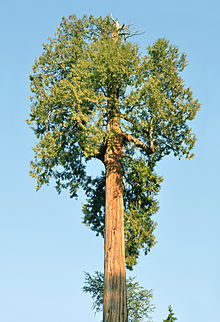Western redcedar
| Thuja plicata | |
|---|---|
 |
|
| An old tree in Vancouver | |
| Scientific classification | |
| Kingdom: | Plantae |
| Division: | Pinophyta |
| Class: | Pinopsida |
| Order: | Pinales |
| Family: | Cupressaceae |
| Genus: | Thuja |
| Species: | T. plicata |
| Binomial name | |
|
Thuja plicata Donn ex D.Don |
|
 |
|
| Range of T. plicata in the Pacific Northwest | |
Thuja plicata, commonly called western or Pacific redcedar,giant or western arborvitae,giant cedar, or shinglewood, is a species of Thuja, an evergreen coniferous tree in the cypress family Cupressaceae native to western North America.
Thuja plicata is among the most widespread trees in the Pacific Northwest. It is associated with Douglas-fir and western hemlock in most places where it grows. It is found at the elevation range of sea level to a maximum of 2,290 m (7,510 ft) above sea level at Crater Lake in Oregon. In addition to growing in lush forests and mountainsides, western redcedar is also a riparian tree, growing in many forested swamps and streambanks in its range. The tree is shade-tolerant and able to reproduce under dense shade.
It has been introduced to other temperate zones, including western Europe, Australia (at least as far north as Sydney), New Zealand, the eastern United States (at least as far north as Central New York), and higher elevations of Hawaii.
The species is naturalized in Britain.
Thuja plicata is a large to very large tree, ranging up to 65 to 70 m (213 to 230 ft) tall and 3 to 4 m (9.8 to 13.1 ft) in trunk diameter, exceptionally even larger. Trees growing in the open may have a crown that reaches the ground, whereas trees densely spaced together will exhibit a crown only at the top, where light can reach the leaves. It is long-lived; some individuals can live well over a thousand years, with the oldest verified being 1460 years.
...
Wikipedia

